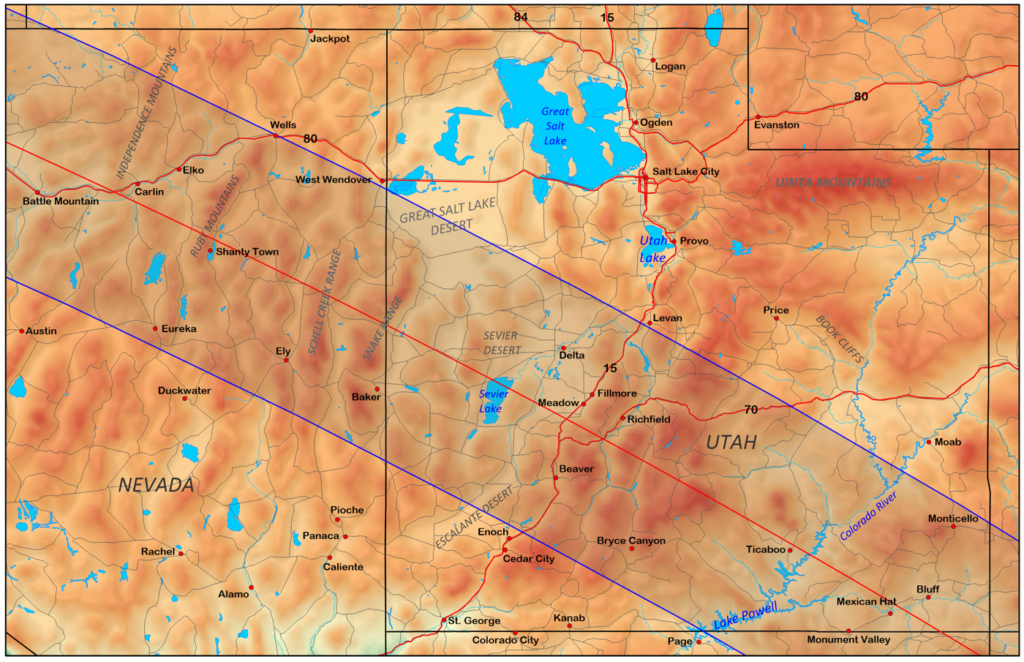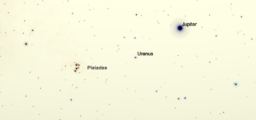Sky Report: September 18 – 24

If you are within this band the moon will be silhouetted in front of the sun on the morning of October 14 in an annular eclipse; if you’re near it the eclipse will be nearly total. From https://eclipsophile.com/ase2023/
This week I want to provide basic information about the near-total eclipse coming up in a few weeks so you can prepare for it. My space is limited and mostly I can just call your attention to it, but Google “eclipse October 2023” for tons of info.
Basically, the next new moon on Saturday, October 14, passes in front of the sun as seen by most of the Western Hemisphere. We’ve had a string of so-called “supermoons” when the full moon is closest to earth. If the full moon is closest, the next new moon, when it’s on the opposite side of its orbit, has to be at its farthest – and smallest – and that’s the case for the new moon on October 14. That new moon eclipses the sun. If you’re standing in the center of the moon’s shadow the moon will be centered on the sun – but , sadly, the moon will be too small to completely cover the sun and produce a wonderful total eclipse. Instead you’ll see what’s called an “annular” eclipse, from the Latin word for “ring” – a super-narrow ring of the sun silhouetted around the moon. That’s if you’re centered in the shadow in a narrow strip of land about 125 miles wide that crosses the country diagonally from Oregon to Texas. If you’re near that strip you’ll see a very deep partial eclipse which will be very dramatic. People farther away will see a partial solar eclipse with a smaller “bite” taken out.
The good news for us is that the centerline, where you see the annular eclipse, passes diagonally through southern Utah! If you are within that path you’ll see the moon framed within the disk of the sun; if you’re near it you’ll see a deep partial eclipse. If you’re elsewhere in Utah, Arizona, Nevada, Colorado, New Mexico you’ll still see a deep solar eclipse – and at no charge by simply stepping outside.
The eclipse unfolds over more than an hour. First the moon “takes a bite” out of the top edge of the sun at 9:09 a.m., the bite becomes larger until maximum at 10:25 (these times are for Kanab; it happens earlier to the west, later to the east), and then the moon moves off.
Of course, clouds ruin the event. Fortunately southern Utah has about a 60% chance of a clear sky.
To view the eclipse you will definitely need a solar filter. Do not make your own; there is still time to purchase inexpensive “solar eclipse glasses”. Amazon and eBay don’t guarantee that their suppliers’ cheap products are safe, so shop there with caution. A complete list of suppliers is at https://eclipse.aas.org/resources/solar-filters.
The planets are pretty much where they were last week and I’ll return to them in my next Sky Report. And if you missed Comet Nishimura you can look forward to Comet Tsuchinshan-ATLAS which may become a naked-eye object next October.
Autumn begins at 12:50 a.m. MDT on the 23rd.
Stellar Vista Observatory provides portable telescopes and tripod mounted binocular kits on loan for free to residents and visitors in Kane County. Enhance your enjoyment of the night sky! To learn more, request a loan, or attend one of SVO’s free public star parties for 2023, visit https://stellarvistaobservatory.org/ or drop in to the Kane County Office of Tourism.






Comments are closed.